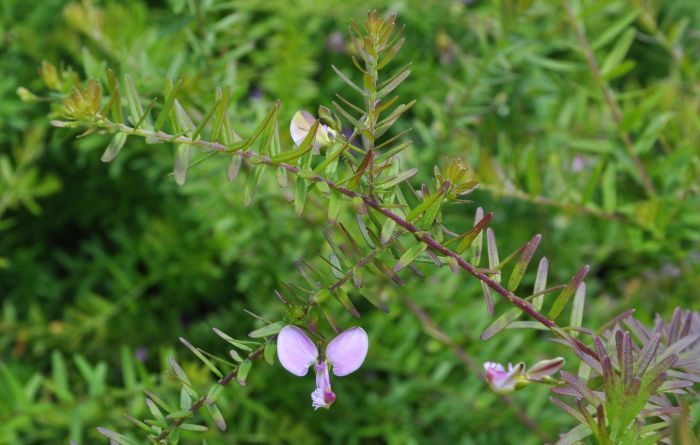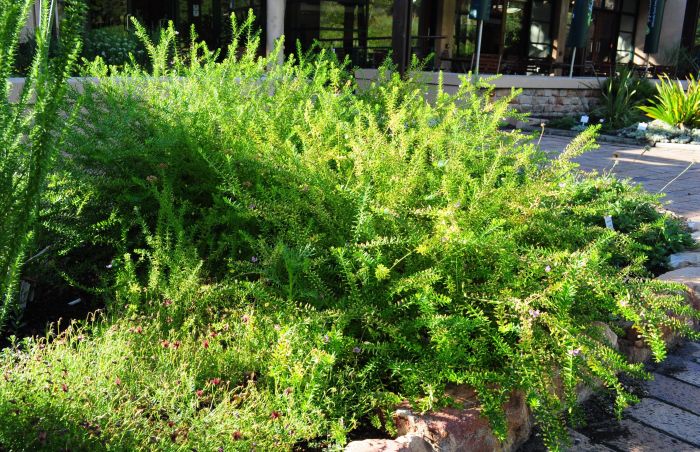Polygala gazensis
Polygala gazensis Baker f.
Family: Polygalaceae
Common names: Gazaland butterfly bush, Gazaland milkwort (Eng.)
Introduction
Polygala gazensis is one of the lesser known polygalas, with an unusual yellow-bronzed tinge to the green foliage that is eye-catching in the garden, particularly when sprinkled with its pretty mauve flowers.

Description
Description
Polygala gazensis is described as an ericoid, sprawling or erect shrub, 1–2 m tall. Leaves of this evergreen shrub are crowded along the stems, narrowly elliptic with a pointed apex, about 25 mm long, with a papery almost leather-like texture. Rather dark, shiny and usually almost glabrous above, lighter and covered with short hairs below. Margins are somewhat rolled under with the lighter underside visible. Flowers on 5–9 mm long pedicels, solitary or in short lateral 2–5-flowered racemes, up to about 10 mm long. The flower colours range from mauve, purple or violet-pink, rarely white. The form of this plant that we have growing at Kirstenbosch National Botanical Garden, has a naturally rounded shape 1 × 1 m, with lighter green, bronze-tinged leaves and many, solitary, light mauve flowers. Peak flowering time is in spring (August to October) while the plant produces a scattering of blooms throughout the year. The fruit is a small, winged, 2-celled, papery, flattened capsule and the seed is small, black and oval shaped. Seeds are thinly dispersed and are covered with fine soft hairs.

The flowers look similar to those of the pea family (Fabaceae), but they are different. The flower is enclosed by 2 large, purple, bonnet-like bracts and streaked with darker veins. These open to show that the flower has a purple tuft of tiny hairs at the top of the lower keeled petal. The outer 2 petals surround the lowest petal like a bonnet. Close inspection will reveal that although they have 2 wings and a keel, they lack the banner (also called standard) petal. A characteristic of all polygalas that makes them easily distinguishable from the pea is a showy, and very distinctive brush-like tuft on the keel. Another distinguishing difference is that polygalas do not bear leguminous fruit.
Conservation Status
Status
Least concern (LC). Polygala gazensis is not threatened.
Distribution and habitat
Distribution description
Polygala gazensis is distributed in Mozambique, Zimbabwe and in South Africa. In South Africa it occurs in the Eastern Cape and KwaZulu-Natal Provinces, where it grows along riverbanks and on margins of evergreen forest and in rocky areas.

Derivation of name and historical aspects
History
The family Polygalaceae is known as the milkwort family or false legume family or butterfly bush family and is one of the largest families and occurs worldwide. It consists of 17 genera and 950 species, which are distributed mostly in warm and temperate countries.
In southern Africa the family comprises 4 genera, namely Heterosamara, Nylandtia, Polygala and Securidaca. The genus Polygala consists of about 600 species with 232 species in Africa and Madagascar, of which approximately 88 species occur in southern Africa, and 32 occur in the Cape region.
The genus name Polygala, derived from the Greek word poly, meaning ‘much’, and gala, meaning ‘milk’, it was named according to the belief that it enhances milk production in livestock, hence ‘milkwort’.
The specific name gazensis means ‘from Gazaland’, the historical name for the region in southern Mozambique and southeastern Zimbabwe. It gets its name from the Swazi Chief, Gaza, the grandfather of Soshangane (d.1856) who built the Gaza Empire that stretched between the Komati and Zambezi Rivers and also included parts of Zimbabwe and South Africa. Today, part of the empire is the Gaza Province of Mozambique. The type was collected in eastern Zimbabwe.
Ecology
Ecology
Polygala gazensis flowers attract insects, bees and carpenter bees with its bright purple and mauve flowers.

Uses
Use
Polygala gazensis has immense potential as an ornamental garden plant.
Growing Polygala gazensis
Grow
This hardy perennial plant grows well in enriched loamy soil, in full sun or lightly semi-shaded areas and requires no special care. When newly planted in the garden, it will require plenty of water to ensure healthy and rapid growth. Once established, it will require less water, particularly if mulch is added. Pruning is not needed as it maintains its compact and rounded habit.
It is ideal as a specimen plant grown to brighten up any patch in your garden, adding a splash of lightness and textural contrast in a mixed border, providing attractive flowers and foliage colour all year round. It can be planted in outdoor containers, as an edging plant, and in mixed borders.

Polygala gazensis is propagated vegetatively using tip or nodal cuttings, or by sowing seed; both methods can be done during either spring or autumn.
Cuttings should be placed in a suitable rooting medium, bearing in mind that a lighter, looser-textured medium will help avoid the possibility of rotting. Rooting hormone powder can be used to increase success. Keep the cuttings in a warm, sheltered, shaded area and water enough to not let them dry out completely, but don't keep them saturated. Use a liquid fertiliser to encourage strong roots and growth until rooting occurs, which can be expected in 6 to 8 weeks. Transplant the rooted cuttings into a good soil mixture in small growing pots, with drainage holes and grow on till large enough to plant out into the garden.
Treat seed with a 12 hour soak in hot water for better germination. Sow in seed trays in a well-drained soil mix and cover lightly with the sowing medium. Keep trays in a warm, sheltered area until germination occurs. To prevent pre- and post-emergence damping off, the seed should be treated with a fungicide prior to sowing, or watered with a fungicide immediately after sowing. Transplant the seedlings after the first pair of true leaves have emerged, or when they are large enough to handle, into individual bags or pots. At this stage, feed moderately with a liquid fertiliser and water generously.
If sowing directly into open garden soil in a winter rainfall climate, then sow only in autumn to give the young plants time to establish themselves before the dry summer months. Similarly, in summer rainfall regions, sow in spring, when the rain returns.
The plant has few pest or disease problems, although if unhappy they will show significant leaf drop especially planted or positioned incorrectly. Mealy bug and aphid infestations can occur infrequently – treat with a suitable recommended pesticide.
Other recommended species are:
Polygala fruticosa ‘Southern Shores’, the southern shores butterfly bush, a neat, rounded shrub up to 1 m tall. The young leaves of this indigenous evergreen are tinged with purple, the shade echoed by the deep purple, winged flowers.
Polygala myrtifolia, the September butterfly bush, is a hardy, quick-growing coastal shrub with lime-green leaves producing masses of purple-pink flowers, mainly from spring to summer.
Polygala virgata, the purple broom, is a sparse shrub with arching branches, bearing graceful sprays of deep purplish pink flowers.
References
- Ebedes, G. 2017. Gardener’s guide to indigenous garden plants of southern Africa. Struik Nature, Cape Town.
- Hyde, M.A., Wursten, B.T., Ballings, P. & Coates Palgrave, M. 2020. Flora of Zimbabwe: Polygala gazensis. https://www.zimbabweflora.co.zw/speciesdata/species.php?species_id=133730, Accessed on 10 September 2020.
- Jodamus, N. 2004. Polygala virgata Thunb. (Polygalaceae). PlantZAfrica. Online. http://pza.sanbi.org/polygala-virgata
- Leistner, O.A. (ed.). 2000. Seed plants of southern Africa: families and genera. Strelitzia 10. National Botanical Institute, Pretoria.
- Manning, J. 2007. Field guide to Fynbos. Struik Publishers, Cape Town.
- Manning, J. 2009. Field guide to wild flowers of South Africa. Struik Nature, Cape Town.
- Van der Walt, L. 2003. Polygala myrtifolia L. (Polygalaceae). PlantZAfrica. Online. http://pza.sanbi.org/polygala-myrtifolia
- Victor, J.E. 2005. Polygala gazensis Baker f. National Assessment: Red List of South African plants version 2020.1. Accessed on 2020/09/10.
- Viljoen, C. & Hitchcock, A. 2002. Polygala fruticosa 'Southern Shores' P.J.Bergius (Polygalaceae). PlantZAfrica. Online. http://pza.sanbi.org/polygala-fruticosa-southern-shores
- Wikipedia, Gaza Empire. https://en.wikipedia.org/wiki/Gaza_Empire. Accessed on 10 Sep. 2020.
Credits
Zoleka May and Cherise Viljoen
Kirstenbosch National Botanical Garden
September 2020
Plant Attributes:
Plant Type: Shrub
SA Distribution: Eastern Cape, KwaZulu-Natal
Soil type: Sandy, Loam
Flowering season: Spring
PH: Acid, Neutral
Flower colour: Purple, Pink, Mauve/Lilac
Aspect: Full Sun, Morning Sun (Semi Shade), Afternoon Sun (Semi Shade)
Gardening skill: Average
Special Features:
Horticultural zones









Rate this article
Article well written and informative
Rate this plant
Is this an interesting plant?
Login to add your Comment
Back to topNot registered yet? Click here to register.